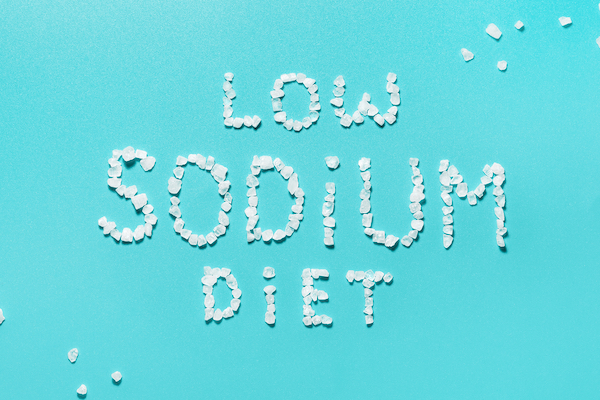
It’s a phrase that we’re hearing more and more often: no-sodium or low-sodium diet. You see it on restaurant menus, on food items in the supermarket, and in health articles in magazines and on the internet. Doctors, registered dietitians, and nutritionists recommend it for some of their patients and there are many cookbooks are dedicated to it.
So what is a low-sodium or no-sodium diet? Do people need to consume sodium? Who should follow such a dietary recommendation? Isn’t a low-sodium or no-sodium diet boring and tasteless? Let’s explore these questions and more.
What is a low-sodium or no-sodium diet?
The definition of a low-sodium diet is one that is “restricted to foods naturally low in sodium content and prepared without added salt” and that is recommended for people who have high blood pressure, kidney or liver dysfunction, and heart failure. This is generally considered to be about 1 teaspoon daily or 2,300 milligrams.
A low-sodium or no-sodium diet means you avoid added salt and foods that contain significant amounts of salt as much as possible. It’s virtually impossible to avoid sodium 100 percent of the time because there is some salt in nearly everything you consume. However, because your body needs sodium, you don’t want to eliminate it entirely from your diet.
Read about ditch the salt shaker, cook with herbs and spices
Do people need sodium?
Yes. While consuming too much salt can contribute to high blood pressure and associated conditions such as kidney problems, heart attack, heart failure, stroke, osteoporosis, and fluid retention, the human body does need some salt for critical functions.
In fact, if you didn’t get enough sodium, you would die. For example, sodium controls the fluid levels in your body and also helps regulate blood pressure, blood volume, and cellular function. Sodium levels are intimately associated with heart health, and it’s also involved in nerve and muscle functioning.
How much sodium do people typically eat?
According to the University of California, San Francisco, the average American consumes about 20 times the amount of table salt (sodium) the body needs. In fact, all you need is ¼ teaspoon daily (500 milligrams) for good health. However, for individuals with medical conditions that can significantly worsen with too much sodium, the general recommendation is less than 2 to 3 grams (2,000 to 3,000 mg) daily. One teaspoon of salt contains about 2,300 mg of sodium.
The National Kidney Foundation, for example, recommends that anyone who has chronic kidney disease consume less than 2 grams of sodium daily.
For individuals with heart failure or other heart conditions, sodium should be limited to 3,000 mg daily if the condition is mild and no more than 2,000 mg for moderate to severe heart failure.
Here’s a quick translation of sodium information on food items:
- Sodium free: only a tiny amount of sodium per serving
- Very low sodium: 35 mg or less per serving
- Low sodium: 140 mg or less per serving
- Reduced sodium: Sodium level is reduced 25%
- Light or lite sodium: Sodium level reduced 50%

Read about the importance of decreasing dietary sodium
How much sodium is in food?
Some foods are naturally very low in sodium, including most fresh vegetables and fruits, many dairy foods (e.g., low-sodium cheese) eggs, olive and avocado oils, unsalted nuts and seeds, fresh or frozen meats (poultry, beef, lamb, pork), fish, rice, dry beans and beans, low-sodium beverages (e.g., tea, coffee), and water or oil-packed poultry or fish. Processed foods, including frozen, canned, boxed, fried, and fast food, are typically high to very high in sodium.
Some examples of foods that should be avoided on a low-sodium or no-sodium diet include hamburgers, pizza, salty snacks, frozen meat dishes, processed meats, salted canned vegetables, canned soups, cottage cheese, cheese, baking mixes, boxed meals, sauces, pickled vegetables, and condiments.
A few vegetables have a greater amount of salt than most of their cousins. They include celery, beets, carrots, Swiss chard, and spinach. It’s best to balance these with any other low-sodium veggies.
Benefits of the low sodium or no-sodium diet for health
A low-sodium or no-sodium diet is often recommended for anyone who has certain medical conditions, such as kidney disease, heart failure, high blood pressure, and stroke. That’s because consuming too much sodium can cause fluid retention and raise blood pressure. Consuming less sodium also can help with recovery from stroke and heart disease as well as reduce the harsh effects of cirrhosis and diabetes, lower levels of bad cholesterol, and help protect your vision.
Did you know, for example, that approximately 37 million adults in the United States have kidney disease, but the vast majority of them don’t even know they are living with this serious condition? A low-sodium/no-sodium diet could be a tremendous help for them.
Did you also know a high-salt diet may increase your risk of developing certain types of cancer such as stomach cancer? On the other hand, a low-sodium diet has been associated with a lower risk of stomach cancer.
How do I make food taste great without adding salt?
Nature has provided us with many herbs and spices which, when added to a single food or a recipe containing several ingredients, can make these dishes explode with flavor. Onion, garlic, smoked paprika, chili pepper, red bell pepper, green bell pepper, orange peel, and more! You won’t even realize there’s no added salt!
Here are two delicious examples to get you started.
Bottom line
A low-sodium or no-sodium diet doesn’t have to be boring or tasteless when you use salt-free herb and spice blends to liven up your meals. When you do, you’ll be taking care of your health and enjoying delicious food at the same time.
[Editor’s Note: Spiceology has an amazing assortment of herb and spice blends including their salt-free blends.]





